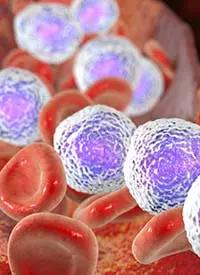Article
cfDNA-Based MRD Assessment Is Feasible, Yields Highly Concordant Results in Relapsed/Refractory CLL
Author(s):
The use of a cell-free DNA–based minimal residual disease assay demonstrated feasibility and highly concordant results compared with 4-color flow cytometry and improved MRD detection in patients with chronic lymphocytic leukemia who were treated with time-limited venetoclax, acalabrutinib, and obinutuzumab.

The use of a cell-free (cf) DNA–based minimal residual disease (MRD) assay demonstrated feasibility and highly concordant results compared with 4-color flow cytometry and improved MRD detection in patients with chronic lymphocytic leukemia (CLL) who were treated with time-limited venetoclax (Venclexta), acalabrutinib (Calquence), and obinutuzumab (Gazyva), according to phase 2 data from the CLL2-BAAG trial (NCT03787264) that were presented during the 2021 International Workshop on CLL.1
Additionally, the cfDNA-based method was identified as a less expensive and quicker method that can complement flow cytometry when the 2 are used in combination, to better improve MRD detection in this patient population.
“cfDNA seems to more accurately reflect the CLL burden in the whole body as opposed to the blood only, and the methods seem to have the biggest advantages compared with flow cytometry in patients with residual lymph nodes and less circulating cells, which is kind of what we expected but hasn’t been shown before,” said lead study author Moritz Fürstenau, MD, of the Division of Hematology, Immunology, Infectiology, Intensive Care, and Oncology at the University Hospital of Cologne in Cologne, Germany, in a virtual presentation during the meeting.
Undetectable MRD (uMRD) status is a predictive factor of improved survival outcomes for patients with CLL. However, conventional MRD assessments through flow cytometry have demonstrated shortcomings, as seen in a pooled analysis.2
Furthermore, patients with CLL who have residual disease in the lymph node compartment have poorer outcomes, despite reaching uMRD status in the peripheral blood and bone marrow, highlighting the unmet need that flow cytometry to assess MRD does not reflect residual disease across all compartments.
In the multicenter, investigator-initiated, phase 2 CLL2-BAAG trial, conducted by the German CLL Study Group, researchers enrolled 46 patients with relapsed/refractory CLL received debulking treatment with bendamustine followed by 1 cycle of obinutuzumab alone before acalabrutinib was added on at cycle 2 and a ramp-up schedule of venetoclax starting at cycle 3. Treatment continued until the maintenance phase and was guided by MRD; it overall lasted between 14 and 34 months.
MRD assessments were utilized by both 4-color flow cytometry and circulating tumor (ct) DNA droplet digital polymerase chain reaction (ddPCR). Results showed that as treatment continued from cycle 5 into the maintenance phase, higher rates of uMRD were detected and varied between the 2 assays.
On day 1 of cycle 5, MRD-positivity rates were 60% and 53% in ctDNA ddPCR and flow cytometry, respectively, before decreasing to 44% and 36% at day 1 of cycle 6, respectively. At the interim stage, the MRD-positivity rate was 38% with ctDNA ddPCR and 31% with flow cytometry.
At the final restaging time point, Fürstenau noted that uMRD rates were highest at 80% with ctDNA ddPCR and 76% with flow cytometry; MRD-positivity rates were 16% and 22%, respectively.
In the first maintenance cycle, the MRD-positivity and uMRD rates were 16% and 78% with both assays. However, in the second maintenance cycle, MRD-positivity rates were 25% and 15% with ctDNA ddPCR and flow cytometry, respectively, and uMRD rates were 65% and 75%, respectively.
MRD levels were more closely evaluated between the 2 assays.
“In cycle 1, so after 3 doses of obinutuzumab, the decrease in MRD is much steeper in the flow cytometry curve, which we explain is the effect of anti-CD20 antibody alone,” said Fürstenau. “In cycle 2, acalabrutinib is started and quite impressively, we see a rapid increase in the median MRD and the flow cytometry curve almost back to baseline levels.”
Fürstenau noted that although flow cytometry mirrors circulating disease only, cfDNA appears to reflect the entire disease burden.
Investigators also sought to question whether MRD detection was improved by combining the 2 methods in this trial. When examining 384 matching cfDNA and flow cytometry samples, 308 of them (80.2%) showed concordant results. It was most prominent that cfDNA and flow cytometry both detected MRD (n = 199) and both detected no MRD (n = 109).
Forty-four samples of 153 samples (28.8%) were detected as having MRD positivity via cfDNA but was previously classified as uMRD by flow cytometry; cfDNA did not detect MRD in 31 samples that flow cytometry did.
“We can state that the 2 methods generated have very concordant results,” said Fürstenau. “The cfDNA-based method has produced highly concordant results compared with the gold standard of flow cytometry, and if we t0ry to quantify the benefit of adding cfDNA to our conventional flow cytometry setup, we see that 44 samples that were assessed as MRD negative by flow cytometry actually still had detectable CLL DNA fragments.”
Discordant results were also investigated in the study. Advantages for cfDNA were reported for patients with low absolute lymphocyte count (P = .009), residual lymphadenopathy (P = .003), and lactate dehydrogenase levels above 200 u/L (P = .027), suggesting that “cfDNA performs particularly well compared with conventional flow in patients with less circulating CLL cells and rather nodal disease.”
Fürstenau concluded that patients on the phase 2 trial will continue be sampled for MRD in the maintenance phase, and future research will aim to determine how accurately cfDNA-based methods will predict duration of remissions to treatment and detections of nodal vs leukemic relapses.
References
- Fürstenau M, Weiss J, Giza A, et al. Cell-free DNA (cfDNA)-based serial minimal residual disease assessment in patients with chronic lymphocytic leukemia treated with time-limited obinutuzumab, acalabrutinib and venetoclax. Presented at: 2021 International Workshop on CLL; September 17-20, 2021; virtual. Abstract 1084129.
- Fürstenau M, Bahlo J, Fink AM, et al. Residual abdominal lymphadenopathy after intensive frontline chemoimmunotherapy is associated with inferior outcome independently of minimal residual disease status in chronic lymphocytic leukemia. Leukemia. 2020;34(3):924-928. doi:10.1038/s41375-019-0597-3






%20(2)%201-Recovered-Recovered-Recovered-Recovered-Recovered.jpg?fit=crop&auto=format)

%20(2)%201-Recovered-Recovered-Recovered-Recovered-Recovered.jpg?fit=crop&auto=format)
%20(2)%201-Recovered-Recovered-Recovered-Recovered-Recovered.jpg?fit=crop&auto=format)